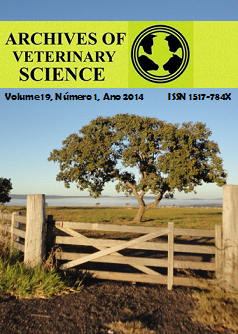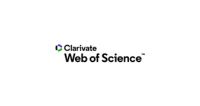COMPARISON OF LONG-TERM PROGESTERONE-BASED PROTOCOL ON REPRODUCTIVE PERFORMANCE OF PREPUBERTAL AND PUBERTAL BEEF HEIFERS.
DOI:
https://doi.org/10.5380/avs.v19i1.32805Palavras-chave:
Pre pubertal. Pubertal heifers. Progesterone. TAI.Resumo
The aim of this study was to investigate estrus synchronization in prepubertal and pubertal heifers (crossbred ½ Nelore x Red Angus - commercial herd) submitted to a long-term progesterone-based protocol for timed artificial insemination (TAI), as well as overall pregnancy rates. Four hundred forty-seven heifers underwent ultrasound examination of the ovaries and were assigned to one of 3 groups: (1) prepubertal heifers (PPNS; n = 114) with ovarian follicles <8 mm in diameter and no corpus luteum (CL) that were submitted to natural service (NS) by bulls for 10 days; (2) prepubertal heifers (PPTAI; n = 124) with follicles <8 mm in diameter and no CL that underwent estrus synchronization with injection of 4.0 mg estradiol benzoate (EB) and insertion of a controlled-release intravaginal progesterone (P4) device containing 0.558 g P4 on d 0, followed by P4 device removal and injection of 150 mg prostaglandin F2α and 0.6 mg estradiol cypionate (ECP) on d 8, and TAI on d 10; and (3) pubertal heifers (PTAI; n = 209) with follicles >8 mm in diameter and/or a CL that underwent the same protocol as PPTAI heifers. Overall pregnancy rate was determined by transrectal ultrasonography on d 45 after NS or TAI. Data were analyzed using the FREQ procedure of SAS (SAS Inst. Inc., Cary, NC). Pregnancy rates were as follows: 20.1% in PPNS, 37.0% in PPTAI, and 48.5% in PTAI (P < 0.05). In conclusion, TAI after estrus synchronization with a hormonal protocol using EB and ECP in prepubertal and pubertal heifers resulted in higher pregnancy rates than prepubertal heifers exposed to natural service, and exposure of prepubertal heifers to a long-term progesterone-based protocol effectively synchronized estrus.
Downloads
Publicado
Como Citar
Edição
Seção
Licença
Autores que publicam nesta revista concordam com os seguintes termos:
- Autores mantém os direitos autorais e concedem à revista o direito de primeira publicação, com o trabalho simultaneamente licenciado sob a Creative Commons - Atribuição 4.0 Internacional que permite o compartilhamento do trabalho com reconhecimento da autoria e publicação inicial nesta revista.
- Autores têm autorização para assumir contratos adicionais separadamente, para distribuição não-exclusiva da versão do trabalho publicada nesta revista (ex.: publicar em repositório institucional ou como capítulo de livro), com reconhecimento de autoria e publicação inicial nesta revista.
- Autores têm permissão e são estimulados a publicar e distribuir seu trabalho online (ex.: em repositórios institucionais ou na sua página pessoal) a qualquer ponto antes ou durante o processo editorial, já que isso pode gerar alterações produtivas, bem como aumentar o impacto e a citação do trabalho publicado.














